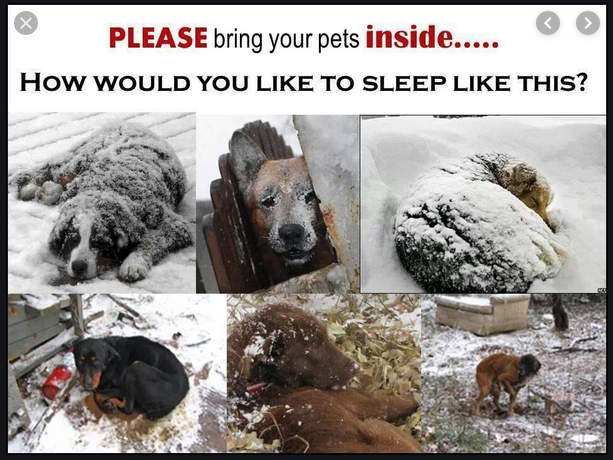FAQs
DSNY Special Waste Drop-Off Sites
Request an Electronics Pick-up
Protect Pets from the Cold


Cold Weather and Animals
As the winter approaches, we would like to remind the community that cold weather can be deadly for pets.
Owners are sometimes not aware that their pets feel the cold as badly as people do. Animals are at risk of hypothermia, frostbite and even death. There is a misconception that pets can weather the cold or a storm because they have fur that will insulate them. But that is not true. And it is worse for pets that are short-haired or hairless. A pet’s ears, paws and tails are especially susceptible to injury.
Protecting Pets from Cold, Salt, Chemicals
Dogs lose most of their body heat from their paw pads, ears and through respiration. If your dog is comfortable in clothing, a sweater or coat with a high collar or a turtleneck that covers him from the tail to tummy is ideal.Booties can help protect paw pads from injury due to snow or ice and also keep salt and other de-icing chemicals away from the skin.
Salt and chemicals are hazardous and can irritate the pads of your pet’s feet. Check your dog’s paws for signs of cold-weather injury or damage during and after walks. Warning signs can include cracked paw pads or bleeding. Sudden lameness may be due to an injury or ice accumulation between toes or paw pads. You may be able to reduce the chance of ice-ball accumulation by trimming the hair between your pet’s toes. Be sure to wipe animals’ paws with a damp towel every time you come in from the outdoors if your pet doesn’t accept wearing booties. All antifreeze is a deadly poison that can be fatal if swallowed. Keep it out of your pet’s reach, and if you see or suspect a pet had access to or ingested antifreeze, seek veterinary attention immediately.
Walk/Outdoor Time
You should shorten your walk time in cold conditions. If it’s below 0 degrees, no dog should be out for a walk or kept outdoors. Always keep an eye on your pets while they are outside. If your pet is barking or crying, it’s a sign that they are suffering. Without proper warm shelter, food and water, these domesticated animals’ chances of survival in frigid temperatures is greatly decreased.
If you care for a primarily outdoor animal, make sure that you provide him with an insulated shelter where he can go to warm up when the weather becomes too intense. This shelter should have a lifted surface to keep him off the cold ground, as well as a blanket, pillow and bed. Try to feed outdoor animals indoors or in their shelters, since water and food can freeze outside.
Cars
Never leave your pet alone in a car in any weather. Freezing temperatures and hot temperatures can both be deadly. In the winter, a car is just like a refrigerator, trapping the cold air inside and can cause a pet to freeze to death.If you suspect that your pet might be suffering from hypothermia or frostbite, take him to the vet immediately.
Feral cats in vehicle engines
Be aware that feral cats may climb into vehicle engines to seek warmth during cold weather. Knock on or check under the hood before starting a vehicle and honk the horn to startle any pets or even wild animals who may have sought shelter in or underneath your car.
Many pets become lost in the winter
Always keep an eye on your pets when they are outside during winter weather. Snow and ice can hide recognizable scents that normally help your pet find his or her way back home. Ensure your pets have a fitted collar with up-to-date identification and contact information and a microchip with updated information, so they are easier to find if they do get lost.
Crime
It can be a crime to leave pets outside in extreme temperatures. If you encounter a pet left in the cold, politely let the owner know you’re concerned. If their respond poorly or their animals continue to be in danger, follow these steps: https://www.humanesociety.org/news/what-do-if-you-see-pet-left-out-cold. “Especially in these cold months, it is important for people to bring their pets inside and for others to report neglected animals to law enforcement,” says Ashley Mauceri, the HSUS manager for cruelty response. If you see a pet left out in the cold, speak out, report what you see: take note of the date, time, exact location and the type of animal(s) involved and write down as many details as possible about the situation. Video and photographic documentation of the animal, the location, the surrounding area, etc. (even a cell phone photo) will help bolster your case.
Questions?
Any pet owners who aren’t sure what protections their pets need during cold weather should discuss this with their vets.
References
Pets dying from the cold: https://www.huffpost.com/entry/dogs-are-dying-from-the-cold_n_5a538039e4b003133eca6ec7
Need to take action? https://www.humanesociety.org/resources/report-animal-cruelty
If you need advice, you can call the Humane Society of the U.S. at https://www.humanesociety.org/contact-us or email them at [email protected]
Cold weather safety tips:
https://www.humanesociety.org/resources/5-ways-protect-pets-winter
https://www.avma.org/public/PetCare/Pages/Cold-weather-pet-safety.aspx
https://www.aspca.org/pet-care/general-pet-care/cold-weather-safety-tips
https://people.com/pets/pet-winter-weather-tips-cold-snow-ice/
https://www.marthastewart.com/1524533/how-care-your-pets-brutal-cold
https://www.humanesociety.org/news/what-do-if-you-see-pet-left-out-cold



